Over the holiday season, I took on a little project. I decided I would take a look at the scheme incoming Notre Dame defensive coordinator Mike Elko employs. I charted 111 defensive plays from games against Clemson, FSU and Temple. Through this I was able to get a good sense of how Elko coordinates a defense.
Base Defensive Alignment
As has been widely reported, Elko’s base defense uses a 4 man front, with 2 linebackers, a rover and 4 defensive backs. In the plays I charted, Wake Forest lined up in a 4 man front 72% of the time. Although the base 40 front is used in all situations, it is primarily called on 1st and 2nd down. In the plays I charted, a 4 man front was used 86% of the time on 1st down and 88% of the time on 2nd down.
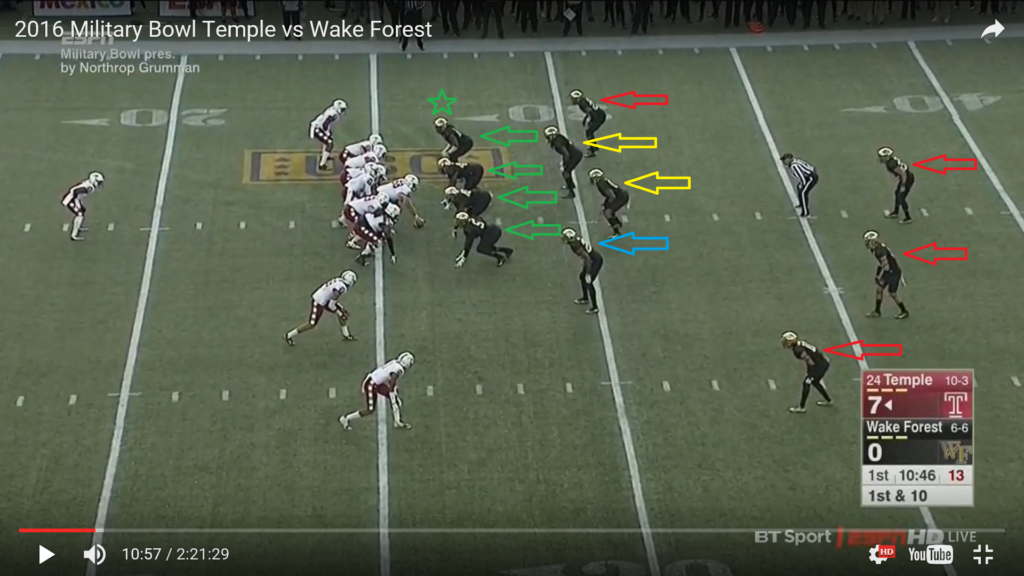
This screen shot gives us a good look at Elko’s base defensive alignment. We’ll start closest to the ball with the defensive line (green arrows). The first thing to note is the stand-up defensive end (green star). Generally speaking he lines up to the weakside. For the most part he is a rush end, but will drop into coverage every now and then. This is very similar to the way Notre Dame used the weakside defensive end position under Brian VanGorder (BVG).
The two inside linebackers (yellow arrows) have similar responsibilities to linebackers in the BVG era. They are asked to fly to the football against the run, blitz on a regular basis, cover man to man and drop into zone coverage. The rover (blue arrow) is supposed to be the wildcard in this position group. I have to say, I charted the alignment of the rover and it was actually a little boring (which isn’t necessarily a bad thing). The rover usually lines up exactly where you see him in this screen shot, to the wide side of the field, over a receiver. The rover in Elko’s 40 front is similar to the SAM linebacker in BVG’s defense. The primary difference is that the rover in Elko’s defense is asked to play man coverage more than the SAM in BVG’s defense.
This screen shot shows a pretty standard alignment for the secondary with corners to the outside and two deep safeties (red arrows). However, this is where things get interesting. The safeties in Elko’s defense are very active. In many ways they are more like rovers than the actual rover position.
Safety Play
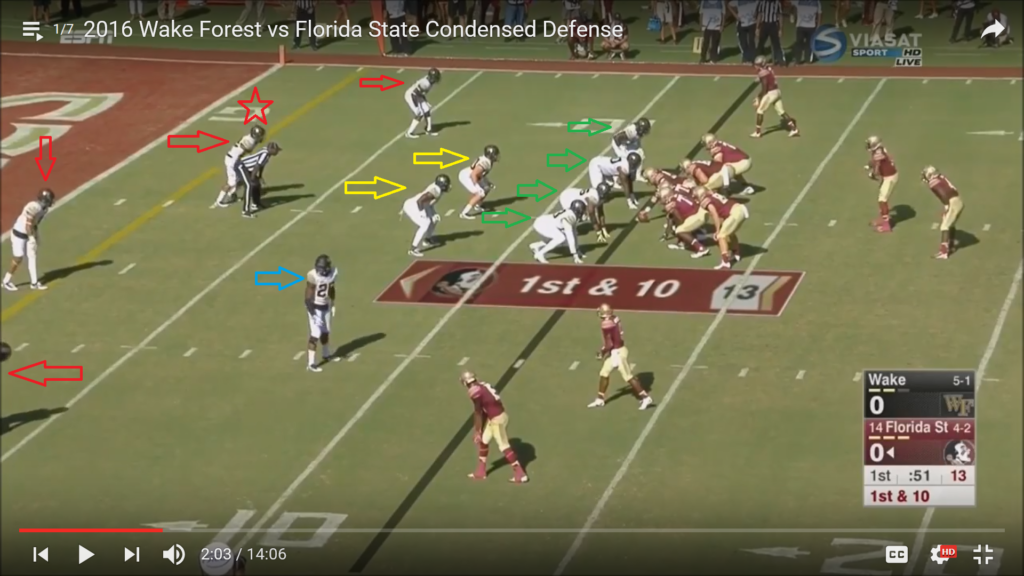
Pre-snap we see the same base alignment highlighted in the previous screen shot. 4 linemen (green arrows), 2 inside linebackers (yellow arrows), 1 rover (blue arrow) to the wide side lined up over a receiver with 2 corners and 2 deep safeties (red arrows). The player to keep your eye on is the strong safety (red star).
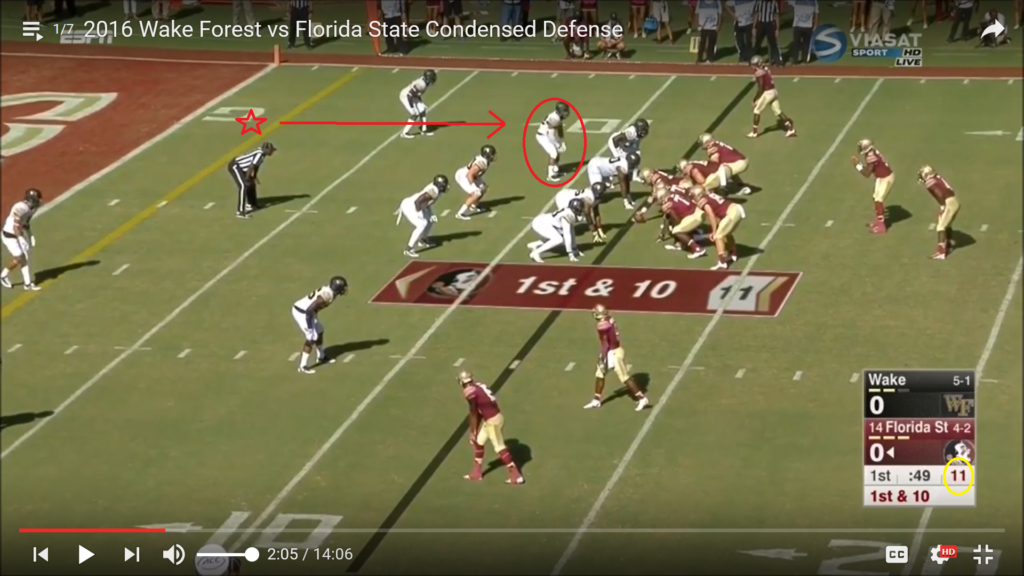
The safety we were watching has moved from depth (red star) towards the line of scrimmage (red arrow, red circle) and will provide extra help with the run. A pretty logical strategy when Dalvin Cook is on the other team. It was clear that using safeties to stop the run was an important part of the game plan against Florida State. On the plays I charted, a safety came from depth towards the line of scrimmage or blitzed 60% of the time.
Take a look at the play clock (bottom right of the screenshot, yellow circle). In the plays I watched it was common for safeties to stay at depth for as long as possible before moving down. This was a tactic designed to make “check with me” offensive play calling a little less effective. As an FYI, Cook ended up getting stuffed for no gain on this play.
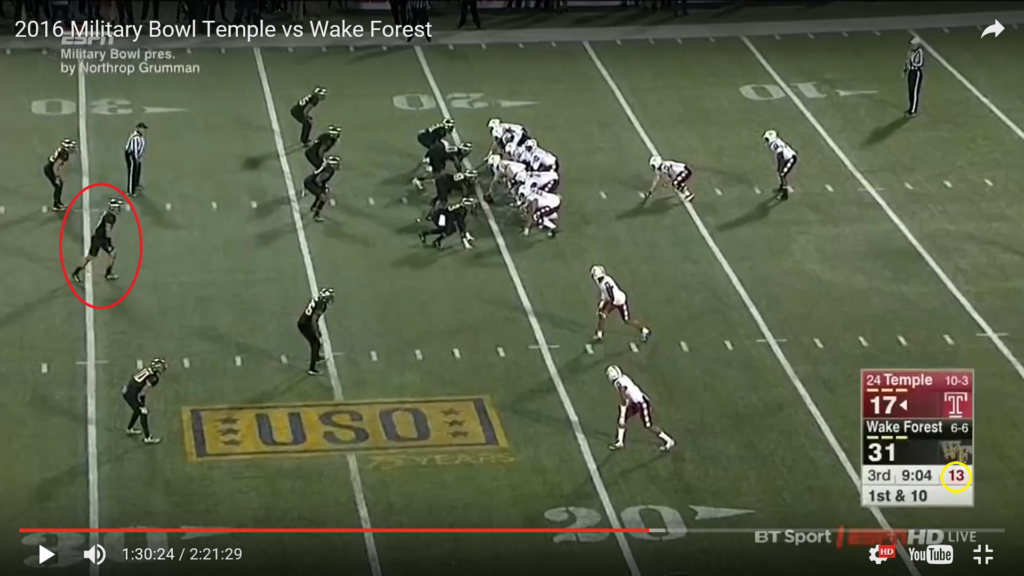
Having a safety come into the box wasn’t just a wrinkle for the FSU game. Moving the safeties towards the line of scrimmage was a consistent theme in the plays I watched. Here we see Wake Forest in another two deep safety look. However, the other safety is starting to move down this time (red circle). Notice how this move also happens as the play clock is winding down (yellow circle).
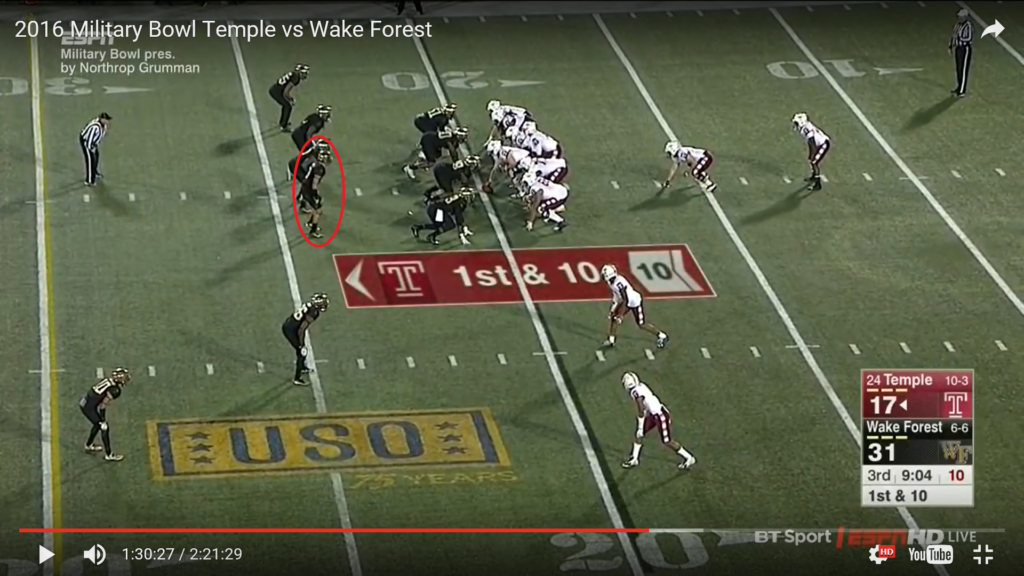
The safety is in the box (red circle) ready to provide immediate run support.
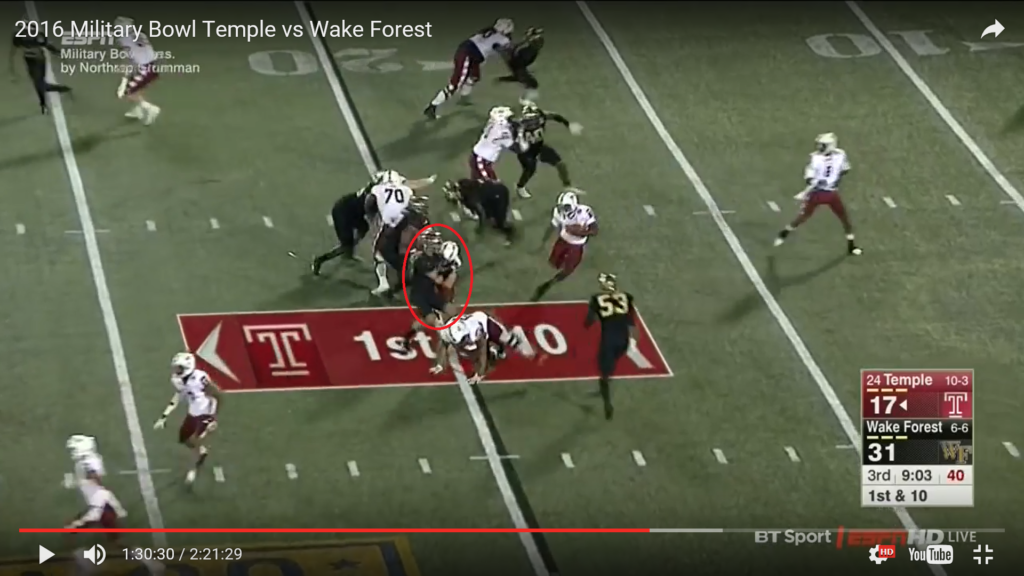
Yup, that’s a safety taking on a fullback at the point of attack (red circle). The last minute adjustment allowed Wake Forest to get an additional defender to stop the run. Although it isn’t ideal to have a safety taking on a fullback on this type of play, he ultimately did a good job and helped cut the play back to the inside where the linebacker was able to make the tackle for no gain.
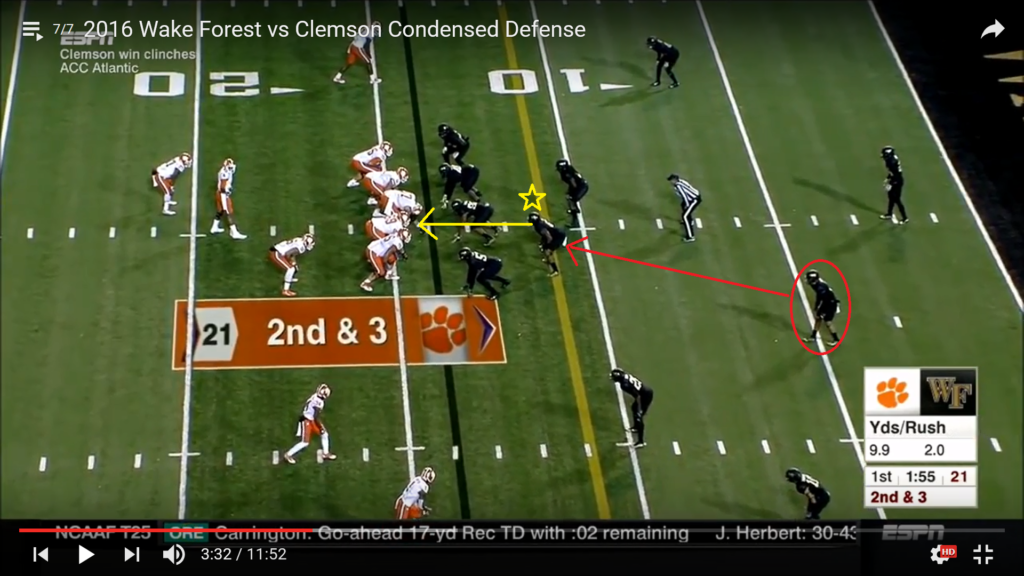
I don’t want to give you the impression that moving safeties towards the line of scrimmage is the only way that Elko activates his secondary. He also likes to blitz from depth. His favourite is to have a safety come late (red circle and arrow) and follow a blitzing linebacker (yellow arrow, yellow star).
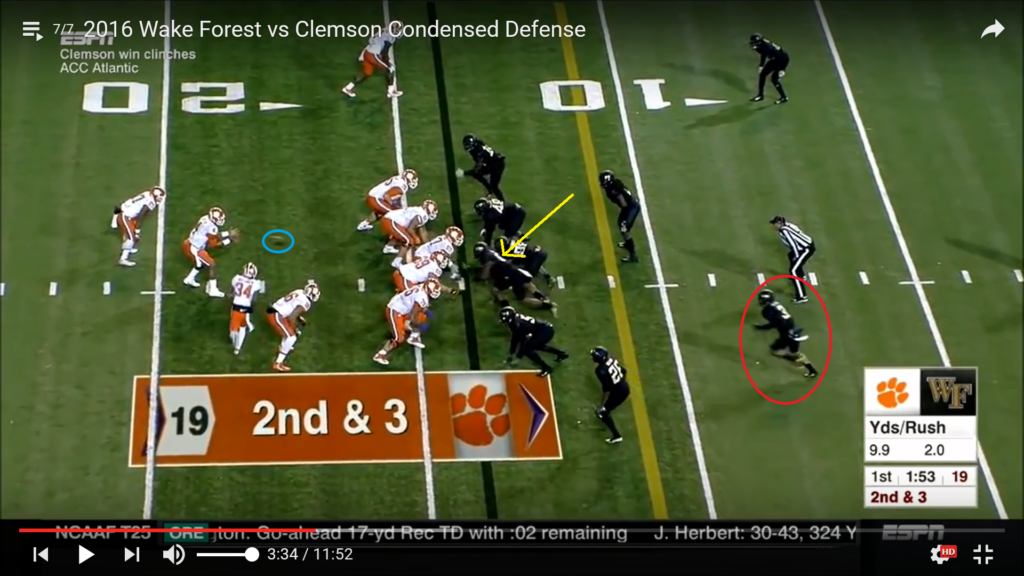
Just after the snap of the ball the safety is sprinting towards the line of scrimmage (red circle) and the linebacker is starting his blitz (yellow arrow). The safety will follow the linebacker for as long as possible and then break off at the last second trying to get into the backfield unblocked.
This screenshot illustrates something else that stood out to me. Elko’s defenses seem to be exceptional at timing blitzes. In this case, the ball isn’t even to the quarterback yet (blue circle) and the linebacker is already partially across the line of scrimmage (yellow arrow). I’m not sure if this is something Elko coaches or if this group of players is just good at timing snaps, but I sure hope we see this sort of timing in South Bend next year.
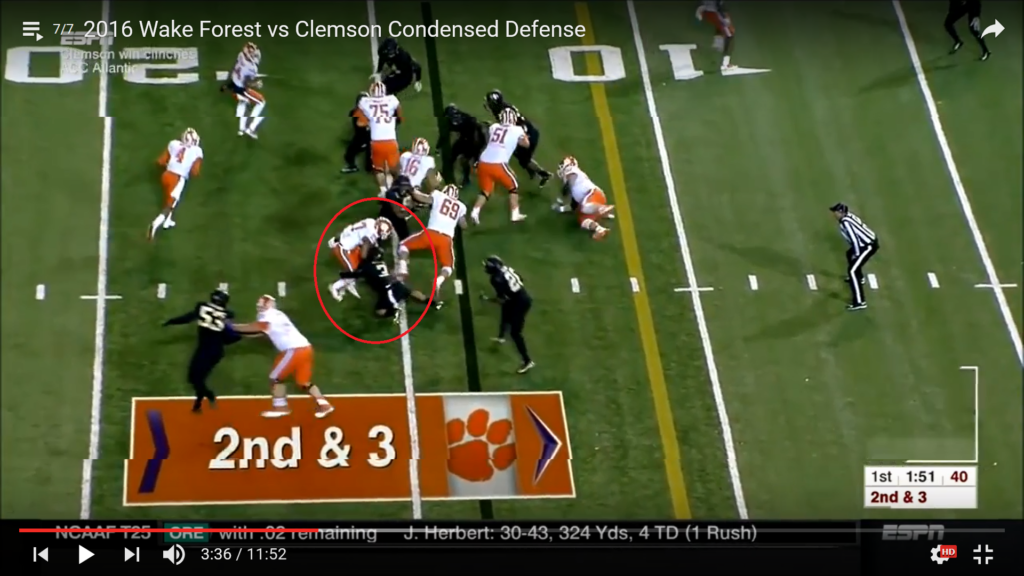
The blitzing safety is unblocked and makes the tackle behind the line of scrimmage (red circle). This type of blitz is pretty simple in that it is designed to overwhelm a single blocker. However, it appeared to be highly effective. When I watched film it was rare that I saw this blitz get picked up by the offense.
Final Thoughts
Elko uses a system that is rooted in a base 4 man front which the players clearly know well. I thought the rover was going to be the wildcard, moving around and giving the base defense a different look and some unpredictability. Turns out I was wrong. The rover’s responsibilities are pretty static in the base defense. When Elko wants to change things up and add some wrinkles on 1st and 2nd down he tends to stay in a 4 man front and activate the safeties. It’s hard to predict what they will do on any given play. They might stay deep, they might come down towards the line of scrimmage, they might play man to man or they might blitz.
At first glance this base defense appears to be similar to what Brian VanGorder used at Notre Dame. In fact, I even saw defensive ends and defensive tackles dropping into coverage! Don’t worry though, there is little question that Elko takes a much different approach to coordinating the defense compared to Brian VanGorder. Elko uses a lot base defense with some nice wrinkles, whereas BVG used a lot of wrinkles with a bit of base defense. The VanGorder approach often led to a defense that looked confused and a step slow. By contrast, the Elko approach often results in a defense that plays fast and aggressive.
Don’t be fooled by the apparent simplicity of the base defense though. Elko has a few tricks up his sleeve. In the next article we’ll see the rover get into the act and take a look at some of the more exotic fronts he uses, especially on third down.

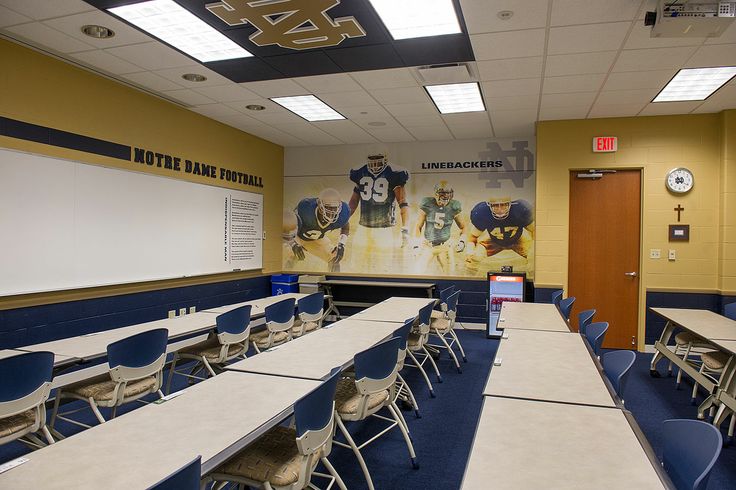


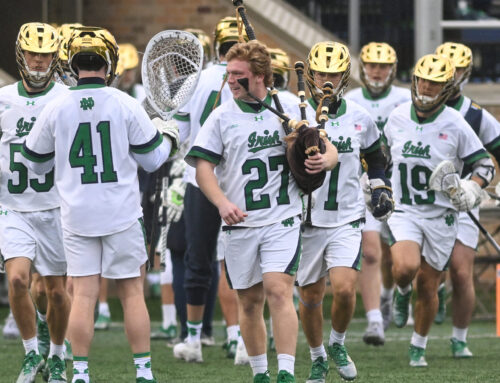
Not a coincidence, I guess, that Elko is DC and coaches safeties??? His arrival should benefit Lyght some and allow him to concentrate more on the CBs. How do you explain the blitz timing, film study?
Excellent work as always Larz. Is it 2017 up there yet? Happy New Year.
That and the higher grade of athletes Elko had to work with compared to BVG.
Thanks tlndma, yeah it’s 2017, although we are in a deep freeze here, so I think time has slowed down, like everything else.
As for your point about the safeties, no doubt there is a strong correlation there. It’s going to be really interesting to see how he uses the safeties at ND, I’m excited about it though.
In terms of blitz timing, I think (and hope) that it is film study and something they work at. I’m surprised more schools don’t do this. With silent snap counts becoming more and more common, it seems like it would be easy to time the snap of the ball.
Could we (maybe) not emphasize the parts of Elko’s scheme that are similar to BVG’s? Those parts make me feel less insanely optimistic about next year.
And a little sick to my stomach.
Similar: 4 down base, likes to blitz.
Different: Blitz designs actually make sense, understands that college kids at smart schools, while smart, don’t have 90 hours a week to watch film and internalize all their read keys, realizes that you have to coach tackling, rather than assume your Wile E. Coyote-schemes will go as planned.
Better?
Similar: Hired to coach defense
Different: Has been successful recently instead of just once in the last ten years
I don’t want to rain on your optimism parade Icod! While they both use a 4 man front, I think you will notice significant positive differences
Great stuff, Larz, thanks.
The BVG comparisons are sure to scare some folks, but it’s important to remember that compared to offense, there really aren’t as many schematic options on the defensive side of the ball. It wasn’t BVG’s base scheme that made it so ineffective or difficult to master. It was the responsibilities within the scheme and how he called it. Too many wrinkles and giving players too many pre and post snap decisions to make tends to slow players down. As does using players in ways that don’t match their skillsets over and over and over. It’s a square peg/round hole thing, but some coaches insist on forcing it for the sake of out-scheming the opposition. That’s when you end up with Joe Schmidt as your primary blitzing linebacker or with Romeo Okwara dropping into coverage more frequently than he rushes the passer.
Nowhere did all of the reads and alignment options cause more confusion than at safety, so I’m really intrigued to see how these young guys look back there under Elko’s tutelage.
I’m looking forward to the breakdown of the Rover play and I’m hoping there’s an article coming with a focus on movement along the DL and how they are used. Again, I don’t think we’ll see much difference with that group than BVG’s scheme, but if they are utilized correctly and if the fundamentals improve, I think we can see better production in the form of pass rush and TFLs.
Thanks FTQ, great summary. As for the defensive line play, I thought Elko did a really nice job with the D-Line. They use a lot of subtle alignments to maximize the effectiveness of blitzes and the pass rush.
Thanks. BTW, I’ve been looking forward to this series since it was teased after his hiring. Great stuff so far.
I wanted to get it done earlier, but it was pretty time consuming!
Appreciate your hard work!
No problem! I really enjoy it and really enjoy our community. The best part is interacting in the comments with everyone.
Great work, Larz, and while there are surface similarities, the differences between this and BVG are evident (ie, doing things that makes sense vs. being complete clownshoes.)
I hate that as an ND fan I’m conditioned to think “this looks great…so how’s he going to screw it all up once he gets to ND.” Kelly runs tempo offense to high scores at Cinci, his QBs can’t get the first play of the game off without calling a TO or getting a penalty at ND…BVG’s “Enn Eff Ell” D promises aggression, but forgets the tackling, coverage, etc…Gilmore’s a great DL coach who’s guys get sacks, and then we have the worst pass rush since 1832…Mike Sanford is an innovative offensive mind who will bring real changes to the offense…or not be allowed to call plays…
I hope Elko’s changes deliver. So does Kelly.
Thanks KG,
Certainly Elko looks promising but like you say, we’ll see what happens next year. I like what he does and think he’s good fit, in particular I think the personnel he inherited are a decent fit for his scheme (not sure what he will do about the rover position yet).
I’m optimistic, but being a ND fan, I’m always cautiously optimistic!
Rover will be interesting. I always assumed that to be a good spot for Tranquill, but is that too much man coverage for him?
It’s a great question. Before I did the research I thought Tranquill for rover. After watching I didn’t think Rover was the best position for him. I don’t think he’s best in space lined up over a reciever. I think they could use him as a safety. Provide run support, playing deep, Blitzing. But I don’t know for sure. I think it will be interesting to see what Elko does with that position.
Will you be doing a piece on who you think plays the different positions?
Not sure on that yet, it’s certainly something to consider. I have some more work to do on his scheme still
Ah, the fresh smell of optimistic hand-wringing.
Eh, screw it. Book it. 2017 Champs ND 14-0! Go Irish!
(Is it 2017 champs or 2018 champs? Football season spilling into the New Year always get me confused…)
It SHOULD be 2017. Either Bama or Clemson will be the 2016 National Champs, since they’re the champs for the 2016 season–even though the title game is played in 2017. Don’t worry, though, even ESPN is confused, at least the podcast I was listening to this morning, where they asked who would be the “2017 National Champs,” either Bama or Clemson.
Gets even worse when I play NCAA on my PS, then I’m like, so…”Manti was a senior for 2012 which means I should play 2009 NCAA to play him as a freshman and win the Heisman, right?” Phft..
Larz, thanks so much for all the hard work, analysis and insight! Like a few of the other posters, I was immediately distressed with the comparison to the BVG scheme… but greatly relieved when I read the approach would be ‘different”. The rover position is and will be intriguing to say the least. Apart from that, would it be fair to say that our future defense will be more of a proponent of the Keep it Simple Stupid (KISS) philosophy or is that an understatement? Like others, I’m excited for the future of our defense but I’ve been drinking the Kool-Aid for a long time! Cheers!
Thanks Greenore!
Yeah, I wouldn’t worry too much about the BVG comparison. The product will be vastly different. I think KISS is a good way to look at it. But there are some nice wrinkles that give it just enough unpredictably
Excellent work, as always.
I do like that Elko doesn’t represent a complete 180 change rather a reasonably similar approach that’s actually done well.
Thanks Shinons, I agree. A complete 180 would be problematic
A complete 360 would be even more problematic!
Thanks, Larz! Great work, as always. This kind of actual football analysis is what makes this the best ND site on the net.
I do have a question/concern that arose while reading through the film study, though. Elko’s defense seems highly dependent on good timing and, as you noted, using late movement to confuse offenses or conceal a blitz. How exactly does that work against up-tempo offenses? What are this defense’s weaknesses against those one-read (Baylor) or fast air-raid (Oklahoma, Washington State) types of teams? Even though Syracuse wasn’t particularly good this year, I’d be interested in some film study from that game (WF held them to 9 points!). One other concern…WF lost to Army. Was that purely a lack of offense or were there some defensive holes as well?
I’m optimistic about Elko. Even an average defense would have had ND in the playoffs in 2015 and probably 8-4 this year, rather than the other way around.
Thanks IB10
I haven’t watched the Army film, I suspect at some point Burgs will dig into that one. I can say in the games I watched the special teams and offense did the defense no favours, so that may be part of it.
In terms of up tempo teams, I don’t think that will cause much of an issue for Elko. A number of times I saw teams snap the ball quick and it didn’t cause major problems, the linebackers were pretty good at reading the keys and getting off the ball. I will say this, teams that snap the ball fast will cause the safeties to blitz more from depth, which means the blitz will take longer to get there. Against the run, that isn’t much of a problem, but against pass it gives the QB more time. I think Elko’s pretty good against tempo teams. One of the reasons for this is his players know the base defense so well, its hard to confuse them. I’m curious to see what he does against power teams like Stanford and Michigan State.
Scoring only 13pts. vs. Army, would lead me to believe much of the blame goes to the WF offense in that loss.
After I watched one of his games I had the same concern about hurry up, but watching multiple hurry up offenses (2015 Indiana, 2016 Clemson) He still disguised coverage they just “shifted” at a different “time”. If you want to take a look at the Army game heres a link (I’m not really qualified to break down triple option defense). https://youtu.be/2TF0qxtgy_U?list=PLvFI28CIIB09kZm39zJ5w47Bj5RtIGCJ2
Great job Lars. I too have been looking for are to this write up. I was not disappointed.
Thanks RK!
Yeah, but at least this defense doesn’t dro-
oh…
But I guess it could be a good thing that the base scheme is similar to BVGs as the learning curve hopefully isn’t overwhelming. I mean, even this year saw improvement when you remove BVGs schizophrenic play calling. Add that in with D. Hayes / Kareem hopefully providing something of an edge rush and guys like Morgan stepping into a leadership role, it’s easy to predict an even better performance in 2017, though I still remain cautious as to how high the defensive ceiling really is next year.
Are you going to do an article that tries to match our roster to Elko’s defense?
I think you raise a good point windy, there was improvement after BVG and I anticipate more improvement next year
Great work Larz! There is something in the two running plays where you used multiple screenshots. In both plays it seems like the weakside DE took the OT out of the play by looping around him to get into the backfield. This seems like it opened up a huge hole for the rest of the defense to get to the ball carrier. Am i just seeing an anomaly from a small sample set? Or could that be by design?
Thanks Dannan,
You have a keen eye. The ends certainly had true contain on some plays (not just an outside rush) and the blitzes would often compliment the contain technique. Elko does a really good job of adjusting alignment and responsibility for the D-Line, it appeared to be very effective in the film I watched.
Awesome, thanks for the reply. i like that answer. It will be really fun to see a defense with 11 parts working together as opposed to several (or more) parts just trying to figure out what they should be doing as the ball carriers goes racing by!
Great job. Very informative.
Thanks cwod!